|
Key words
blood coagulation, fibrin, thrombin, tissucol
|
|
|
|
|
|
|
|
|
|
|
|
|
|
|
|
|
|
|
 |
|
|
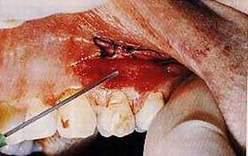 |
|
|
|
|
2. Having
prepared the receiving bed by baring the periosteum and freeing it of
all overlying muscle and connective tissue, having apically stabilized
the mucous flap to the periosteum with single stitches, two drops of Tissucol
with thrombin at a concentration of 4 I.U./ml are applied.
|
1. Insufficient
adhering gum at 2.4 (the alveolar mucosa, due to its elastic structure
and with only one layer of cells, is not suitable to act as marginal gum
and provide the epithelial attachment for the tooth, to maintain the "seal"
and to support chewing trauma.
|
|
|
|
|
|
|
|
|
|
|
|
|
|
|
|
|
|
|
|
|
|
|
|
|
|
|
|
|
|
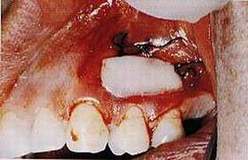 |
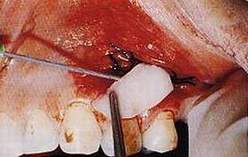 |
|
|
|
| 3. The free
graft is adapted. |
|
|
|
|
|
|
|
|
4. Following light compression
for eight minutes the graft has adapted. |
|
|
|
|
|
|
|
|
|
|
|
|
|
|
|
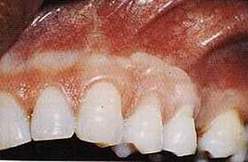 |
|
|
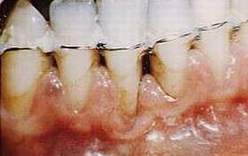 |
5. Healing
after three months: the adhering gum has increased but the graft has undergone
severe contraction and its blending is not good; the glue may have been
reabsorbed too slowly. The appearance of the graft following removal of
the first pack was not the healthiest. This may be due to a too-intense
action of the aprotinina which, by inhibiting local fibrinolysis, may
have interfered with the tropism of the graft.
|
|
|
|
|
|
|
|
|
|
6. Insufficient gum adhering
to the four lower incisors. |
|
|
|
|
|
|
|
|
|
|
|
|
|
|
|
|
|
|
|
|
|
|
|
|
|
|
|
|
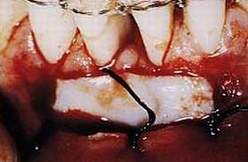 |
|
|
|
|
|
|
|
|
|
|
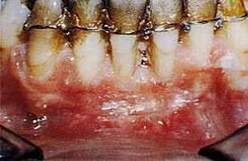 |
|
|
|
|
|
|
|
|
|
|
|
|
|
|
7. Free gingival graft
with Tissucol prepared with thrombin at a concentration of 4 I.U./ml after
diluting the aprotinina by 50% with water for injectable solutions in
order to have faster reabsorption of the glue.
|
|
|
|
|
|
|
|
|
|
|
|
8. Blending of the graft
is quite good. |
|
|
|
|
|
|
|
|
|
|
|
|
|
|
|
|
|
|
|
|
|
|
|
|
|
|
|
|
|